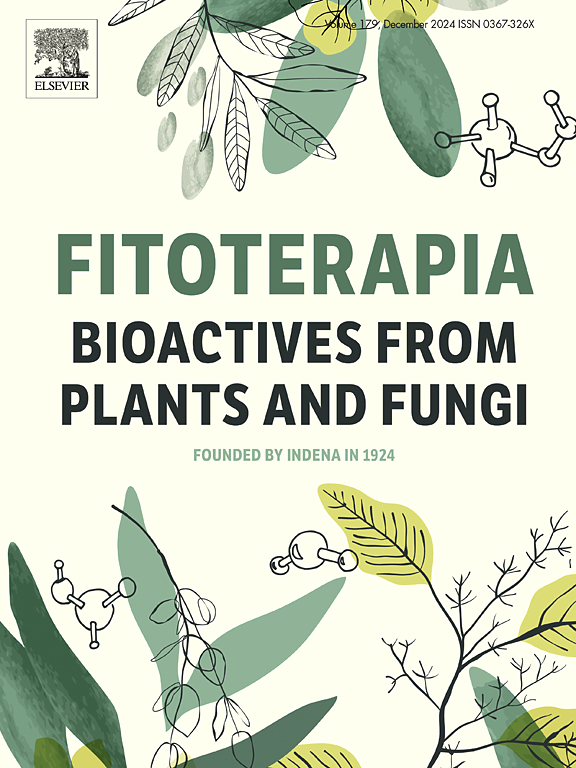Polygala tenuifolia root extract attenuates ischemic stroke by inhibiting HMGB1 trigger neuroinflammation
IF 2.5
3区 医学
Q3 CHEMISTRY, MEDICINAL
引用次数: 0
Abstract
Polygala tenuifolia Willd., a famous traditional Chinese medicine, has been widely applied to treat central nervous system diseases. In this study, P. tenuifolia root extract exhibited a moderate anti-ischemic effect on in-vitro oxygen-glucose deprivation/reperfusion (OGD/R) model. In transient middle cerebral artery occlusion (tMCAO) rats, P. tenuifolia root extract significantly attenuated brain infarction and neurological deficits in a dose-dependent manner. Compared with the sham group, the release of damage-associated molecular patterns (DAMPs)-HMGB1 in the ischemic brain was significantly higher, which was inhibited by P. tenuifolia root extract. To further explore such neuroprotective effects whether associated with aseptic inflammation, HMGB1-activated BV2 microglial cells model was established. The extract of P. tenuifolia was found to inhibit the downstream inflammatory response driven by HMGB1, with an IC50 value of 49.46 μg/mL. In addition, the extract was also found to be able to directly interact with HMGB1 in the surface plasmon resonance (SPR) experiment. Phytochemical studies showed that the extract of P. tenuifolia root contains a large number of terpenoids, oligosaccharides and phenolic compounds, which likely contribute to the above observed biological activities. Our results not only provide some data support for the clinical application of P. tenuifolia against cerebral ischemia, but also clarify the potential target of P tenuifolia's anti-inflammatory properties.

远志根提取物通过抑制 HMGB1 引发的神经炎症减轻缺血性中风的症状
远志是一种著名的传统中药,被广泛应用于治疗中枢神经系统疾病。本研究发现,远志根提取物在体外氧-葡萄糖剥夺/再灌注(OGD/R)模型中表现出中等程度的抗缺血作用。在瞬时大脑中动脉闭塞(tMCAO)大鼠中,天南星根提取物以剂量依赖的方式显著减轻脑梗塞和神经功能缺损。与假组相比,缺血脑中损伤相关分子模式(DAMPs)-HMGB1的释放量明显升高,而天南星根提取物可抑制DAMPs的释放。为了进一步探讨这种神经保护作用是否与无菌性炎症有关,我们建立了 HMGB1 激活的 BV2 微神经胶质细胞模型。研究发现,白头翁根提取物能抑制由 HMGB1 驱动的下游炎症反应,其 IC50 值为 49.46 μg/mL。此外,在表面等离子体共振(SPR)实验中还发现该提取物能与 HMGB1 直接相互作用。植物化学研究表明,P. tenuifolia 根提取物中含有大量萜类化合物、低聚糖和酚类化合物,这些化合物很可能有助于上述生物活性的观察。我们的研究结果不仅为防脑缺血的临床应用提供了一些数据支持,而且还明确了白头翁抗炎特性的潜在靶点。
本文章由计算机程序翻译,如有差异,请以英文原文为准。
求助全文
约1分钟内获得全文
求助全文
来源期刊

Fitoterapia
医学-药学
CiteScore
5.80
自引率
2.90%
发文量
198
审稿时长
1.5 months
期刊介绍:
Fitoterapia is a Journal dedicated to medicinal plants and to bioactive natural products of plant origin. It publishes original contributions in seven major areas:
1. Characterization of active ingredients of medicinal plants
2. Development of standardization method for bioactive plant extracts and natural products
3. Identification of bioactivity in plant extracts
4. Identification of targets and mechanism of activity of plant extracts
5. Production and genomic characterization of medicinal plants biomass
6. Chemistry and biochemistry of bioactive natural products of plant origin
7. Critical reviews of the historical, clinical and legal status of medicinal plants, and accounts on topical issues.
 求助内容:
求助内容: 应助结果提醒方式:
应助结果提醒方式:


